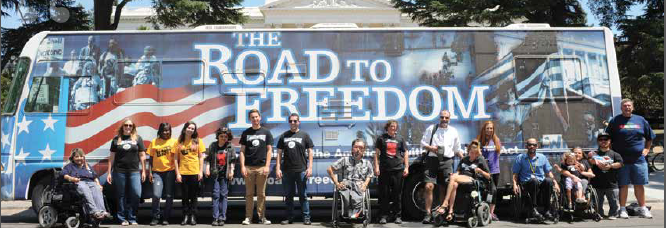July 26, 2015: 25 Years of Emancipation

The Civil Rights Act of 1964 was the beginning of a new era in civil and human rights. By signing the law on July 2, 1964, President Lyndon B. Johnson completed what his predecessor, President John F. Kennedy, had started. The act made discrimination on the basis of race, color, religion, sex or national origin illegal and paved the way for school desegregation, access to voting, public entities and services.
Although the law was born out of bigotry, inequality, conflict and violence, its legacy 50 years later is a positive one. In a March 2014 CBS poll, eight in 10 Americans think the Civil Rights Act has had a positive effect on the country. In order to comprehend present-day public attitudes, policy, education or technology, we must understand the past – how things began and evolved.
History is about our journey as a society and culture. When you put all the pieces together, it increases our understanding and appreciation of progress and the work that remains. When we study atrocities committed in the past, we identify the causes. This can help us prevent future mistakes. It can also help us shape the future. People like Mahatma Gandhi, Martin Luther King, Jr., Ed Roberts and Justin Dart have contributed important lessons related to civil and human rights. All their great work will be wasted if we do not understand their teachings and appreciate the work done by them and their supporters.
It's important that we study the past and use it to mentor the next generation. In passing the Americans with Disabilities Act (ADA), Congress made it clear that Americans with disabilities, similar to Americans who had faced discrimination based on race, color, gender or age, had been subjected to discrimination and prejudice, and should not be denied the opportunity to pursue the American dream.
Unfortunately, prior to the ADA, individuals who were discriminated against on the basis of a disability had few legal tools to combat discrimination and barriers to inclusion. The ADA established absolutely that individuals with disabilities, as a group, had been disenfranchised socially, vocationally, economically and educationally. The Shepherd Center hosted an ADA25 Summit in 2012.
What emerged was a concept and The ADA Legacy Project. The mission of the project is to honor the contributions of people with disabilities and their allies by:
•Preserving the history of the disability rights movement
•Celebrating its milestones, like the ADA
•Educating the public and future generations of advocates.
Presently, The ADA Legacy Project and Disability Rights Center (DRC) have organized a 35+ city cross-country ADA Legacy Tour to highlight the Project's mission and ADA25. The Tour kick-off was on July 25 in Houston, the home of former President George H. W. Bush, who signed the Americans with Disabilities Act into law in 1990. The purpose of the legacy tour is to: raise awareness and excitement about the 25th anniversary of the ADA in 2015; share the history that led to passage of the ADA (preservation), its impact today (celebration),
and the issues that remain to be addressed (education); and facilitate connections with individuals and organizations at the local level.
There will be two stops in Atlanta coinciding with the National ADA Symposium (May 0-13, 2015) and Society for Disability Studies (SDS) Conference, (June 10-13, 2015). Representatives of the Georgia Disability History Alliance and other local groups are working with the organizers of both these conferences. Partnerships are central to the success of The ADA Legacy Project and ADA25. Since 2012, project leaders have developed 30-plus strategic partners in addition to DRC, the National Center for Civil and Human Rights (NCCHR) and the Richard B. Russell Library for Political Research and Studies at University of Georgia.
For example, the Minnesota Governor's Council on Developmental Disabilities started producing the following for their project "Moments in Disability History." The selection of "moments in disability history" cover a wide range of audio and video clips,
historical documents, images and slides from over a span of decades. These chosen "moments" draw upon seminal work from the past that laid the foundation for the ADA and other disability policy. They are the "moments" every self-advocate, parent and professional advocate should know and be literate about in order to create future policy. For purposes of focus and specialization, the "moments" selected do not include activities, events, programs and projects that are about the delivery of programs and direct services.
The selection of "moments in disability history" provide a common ground and foundation for the study of disability history. They have left an indelible mark on public policy and reflect many defining moments of the last 50 years. These are events that have contributed to the forming of American society as we know it today. The events or aftermath of the events, changed history and their impact still resonates with us today.
Lastly, The ADA Legacy Project is committed to educating the next generation. As John D. Kemp, president & CEO of The Viscardi Center and an ADA Legacy Project council member wrote in a recent blog post for NCCHR:
"I see ADA25 as another starting point. A starting point for educating employers about the talented workers with disabilities they are leaving on the sidelines. A starting point for changing mindsets so others welcome our
differences and recognize our similarities. A starting point to rally our next generation of disability rights leaders and advocates. Let's use this next year to bring attention to and acknowledge influential individuals with disabilities who are today's mentors and role models so that young people with disabilities see the extraordinary leaders that they themselves can relate to – leaders with disabilities they can aspire to become."
by Mark Johnson
MARK JOHNSON is the director of advocacy for the Shepherd Center, the top spinal cord & brain injury rehabilitation hospital in the nation. Johnson also serves as the council chair for The ADA Legacy Project.
Tags: Making a Difference, ADA Legacy
